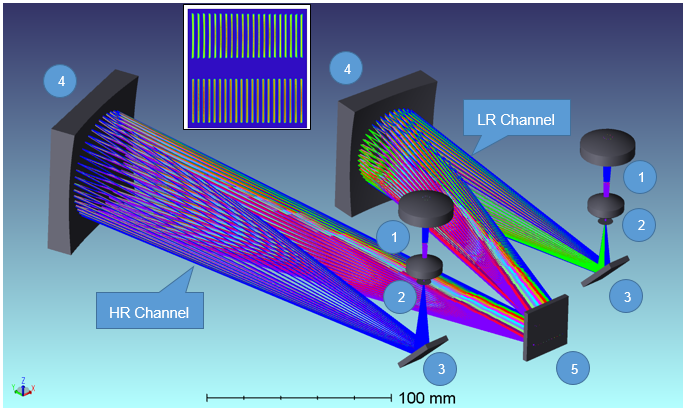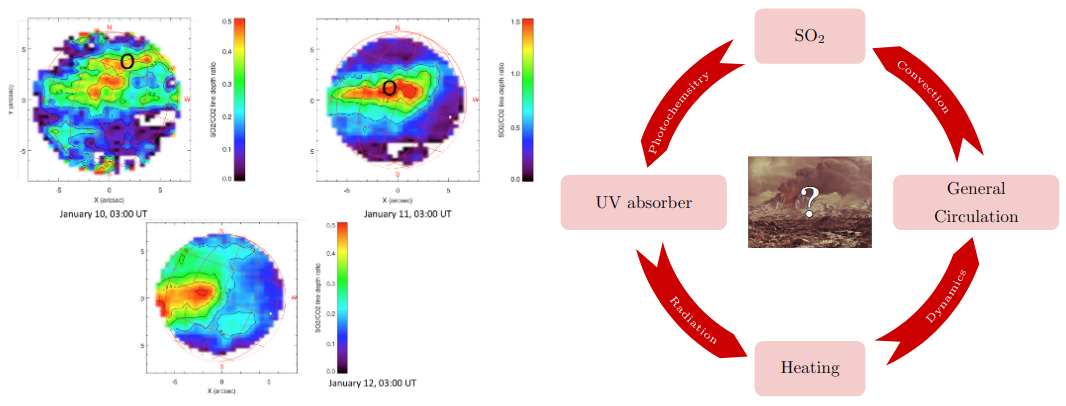The VenSpec-U Ultraviolet Spectral Imager on board EnVision
- 1Université Versailles Saint-Quentin, IPSL, LATMOS, Guyancourt, France (emmanuel.marcq@latmos.ipsl.fr)
- 2Hensoldt Space Consulting, Guyancourt, France
- 3IRAP, CNRS-Univ. of Toulouse-UPS-CNES, Toulouse, France
- 4LESIA, CNRS, Observatoire de Paris-PSL, Meudon, France
- 5IAA-CSIC, Granada, Spain
- 6DLR-PF, Berlin, Germany
- 7Royal Belgian Institute for Space Aeronomy, Brussels, Belgium
Introduction
The VenSpec-U instrument is part of ESA’s EnVision mission (to be launched in 2031) as a core element part of the VenSpec instrumental suite. Its main scientific objectives are to study mesospheric gas variations as well as cloud and particulate variability, and how they are linked to intrinsic atmospheric processes or external forcings (e.g. volcanism). VenSpec-U is consequently dedicated to the monitoring of the cloud top sulphured gases (SO, SO2), as well as cloud top altitude and UV albedo contrasts through spectral and spatial analysis of backscattered sunlight on the dayside of Venus.
Instrument Description
Observations are performed on a “pushbroom” observational strategy, in a nadir or near-nadir (emission angle < 20°) geometry thanks to a UV imaging spectrometer operating in the 190 – 380 nm spectral range. Spectral resolutions shall be better than 0.2 nm in the 205 – 235 nm range (typical SNR of 100 or above at 220 nm), and better than 2 – 5 nm in the 190 – 380 nm range (typical SNR of 200 or above at 220 nm). Spatial sampling shall range from 3 km to 24 km, depending on spectral resolution and orbiter altitude. The narrow-slit axis of the instrument contains the spectral information, whereas the long-slit axis contains the spatial information along the 20° field of view. The remaining spatial direction is provided through orbital scrolling. The VenSpec-U instrument is therefore based on a dual-channel architecture, high spectral resolution (HR) and low spectral resolution (LR). Each channel consists of an entrance baffle, an objective and a spectrometer mainly composed of a slit, a short-pass filter and a spherical holographic grating. Each slit image is formed on a shared CMOS back-side illuminated detector. The detector is controlled such that the integration time and the binning scheme is adjusted independently (and simultaneously) for each channel giving high flexibility and providing parameters for the optimisation of each acquisition. Calibration will be performed through regular Sun observations, through pinholes or using a blank diffuser.

Figure 1: Optical layout of VenSpec-U. 1:Objectives, 2: Slits, 3: Filters, 4: Gratings, 5: Shared detector
Science Objectives
SO2 climatology The monitoring of sulfur dioxide (SO2) above the clouds of Venus has been ongoing since the 1980s, revealing significant variability. Measurements from spacecraft like Pioneer Venus Orbiter and Venera 15, as well as from Earth-based telescopes, have shown that SO2 levels vary greatly both temporally and spatially. In lower latitudes, variability spans three orders of magnitude, while at high latitudes (beyond ±50°), SO2 levels remain consistently low. Most variability occurs in localized and transient SO2 "plumes", which last for a few Earth days and cover about 1000 km.
The short lifespan of SO2 above the clouds suggests rapid photochemical reactions as primary sink for SO2. Vertical mixing from the lower atmosphere replenishes SO2 above the clouds. Fluctuations in vertical mixing may also occur due to atmospheric oscillations, further complicating the understanding of SO2 variability, and highlighting the need for a more accurate and extensive temporal and spatial characterization.

Figure 2: Left: SO2 plumes as observed by TEXES/IRTF; Right: putative closed feedback loop yielding spontaneous oscillations of these known to vary atmospheric quantities
SO:SO2 ratio measurements Observations have also focused on the relative abundance of sulfur monoxide (SO) to SO2, crucial for understanding sulfur chemistry and the above mentioned photochemical destruction of SO2. However, the overlap in absorption spectral bands necessitates high spectral resolution for accurate measurements. Studies using instruments like STIS on board the Hubble Space Telescope have found varying SO:SO2 ratios, impacting the interpretation of SO2 retrievals which usually assume a fixed value for the SO:SO2 ratio.
UV absorber monitoring Venus' upper clouds also contain an unidentified species that absorbs near UV light. This UV absorber's long-lasting presence allows for cloud tracking and wind speed measurements. Long-term monitoring reveals decennial variability in Venus' albedo, suggesting complex interactions between atmospheric parameters like SO2 levels, solar heating through UV absorption and general atmospheric circulation.
Small scale processes Small-scale (<10 km horizontal resolution) observations have identified convective structures and linear wave fronts at cloud top level, indicating a coupling between topography and atmospheric circulation. These observations raise questions about the existence of similar contrasts in other parameters, such as SO2 and SO column densities and/or cloud top altitude. Such observations would aid in refining mesoscale models and large eddy simulations including chemistry and microphysical processes, contributing to a better understanding of Venus' atmosphere at horizontal scales ranging from a few kilometers to several thousands kilometers.
How to cite: Marcq, E., Lustrement, B., Bertran, S., Lasue, J., Vinatier, S., Lara, L., Conan, L., Lefèvre, M., Alemanno, G., Vandaele, A. C., Robert, S., and Helbert, J.: The VenSpec-U Ultraviolet Spectral Imager on board EnVision, Europlanet Science Congress 2024, Berlin, Germany, 8–13 Sep 2024, EPSC2024-335, https://doi.org/10.5194/epsc2024-335, 2024.